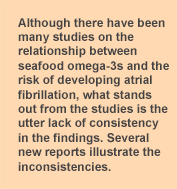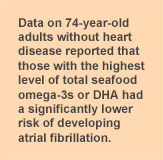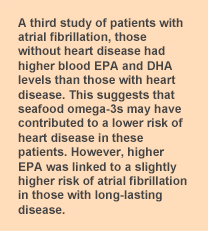
 Fats of Life
Fats of Life has previously reported studies on the relationship between long-chain or seafood omega-3 fatty acids and the risk of
atrial fibrillation, a potentially dangerous, rapid quivering of the upper chambers of the heart. In this condition, the electrical signals in the heart’s upper chambers become disordered and rapid, which compromises the lower chambers’ ability to pump blood effectively. What stands out from all the studies on omega-3s and atrial fibrillation is the utter lack of consistency in the findings. The majority of studies have reported either no association or a significantly lower risk with higher omega-3 status or consumption. Such mixed results do not support a recommendation that might help patients with the condition. However, the effect of seafood omega-3s continues to be investigated because the risk of stroke, heart attack or death is substantial for individuals with the condition and ways of controlling the abnormality are limited. It would be more than convenient if greater intakes of seafood omega-3s could be counted on to lower the risk of recurrence or development in the first place.

Several new reports illustrate the inconsistencies. A study on 74-year-old US adults without atrial fibrillation examined the relationship between total and individual seafood omega-3s in blood and the likelihood of developing atrial fibrillation according to the concentration of omega-3s. They observed that individuals with the highest levels of all seafood omega-3s were significantly less likely (29% lower risk) to develop atrial fibrillation compared with participants in the lowest omega-3 consumption group. The same relationship was seen for the highest intakes of DHA (23% lower risk). EPA levels were not associated with risk. Analysis of data f

rom another similar-sized US study of 54-year-old adults reported that neither the consumption of fish or plasma EPA plus DHA level was associated with risk of atrial fibrillation over more than 17 years of monitoring. Why were these studies so different? Was the difference in risk largely due to the age of the participants? Were fish consumption or plasma fatty acid levels too low? Participants in the first study consumed more than twice as much fish as in the second study and had higher blood levels, so it is possible that seafood omega-3 intakes were too low for any effect in the second study. Supporting that idea was the observation in the second study that participants who had the highest intakes of oily fish or canned tuna had lower risks of atrial fibrillation, but the numbers were too small to reach statistical significance.

A third study among Japanese patients with atrial fibrillation examined blood fatty acids in those with and without ischemic heart disease and compared the observations with patients having ischemic heart disease and no atrial fibrillation and with healthy controls with neither condition. Among patients with atrial fibrillation, those who did not have ischemic heart disease had significantly higher blood EPA and DHA levels, suggesting that higher seafood omega-3s were associated with a lower risk of ischemic heart disease. Overall, DHA concentrations did not differ among the groups. The study also observed that patients with the more long-lasting types of atrial fibrillation had higher EPA concentrations in their blood. When taking all possible confounding factors into consideration, only EPA was associated with a slightly higher risk of atrial fibrillation. However, the small numbers of patients in this study limit the strength of the results. Thus, one cannot draw conclusions about EPA from these observations. What do these studies tell us about omega-3s and atrial fibrillation? One point they illustrate is that intakes of seafood omega-3s have to be sufficiently great to affect risk favorably. It is also possible that older adults who remain free of cardiovascular disease at the time they are observed may already be at lower risk of heart disease and atrial fibrillation, even though they were originally drawn randomly from the community. Alas, we remain without clear answers about the relationship between seafood omega-3s and the risk of developing atrial fibrillation.

 Fats of Life has previously reported studies on the relationship between long-chain or seafood omega-3 fatty acids and the risk of atrial fibrillation, a potentially dangerous, rapid quivering of the upper chambers of the heart. In this condition, the electrical signals in the heart’s upper chambers become disordered and rapid, which compromises the lower chambers’ ability to pump blood effectively. What stands out from all the studies on omega-3s and atrial fibrillation is the utter lack of consistency in the findings. The majority of studies have reported either no association or a significantly lower risk with higher omega-3 status or consumption. Such mixed results do not support a recommendation that might help patients with the condition. However, the effect of seafood omega-3s continues to be investigated because the risk of stroke, heart attack or death is substantial for individuals with the condition and ways of controlling the abnormality are limited. It would be more than convenient if greater intakes of seafood omega-3s could be counted on to lower the risk of recurrence or development in the first place.
Fats of Life has previously reported studies on the relationship between long-chain or seafood omega-3 fatty acids and the risk of atrial fibrillation, a potentially dangerous, rapid quivering of the upper chambers of the heart. In this condition, the electrical signals in the heart’s upper chambers become disordered and rapid, which compromises the lower chambers’ ability to pump blood effectively. What stands out from all the studies on omega-3s and atrial fibrillation is the utter lack of consistency in the findings. The majority of studies have reported either no association or a significantly lower risk with higher omega-3 status or consumption. Such mixed results do not support a recommendation that might help patients with the condition. However, the effect of seafood omega-3s continues to be investigated because the risk of stroke, heart attack or death is substantial for individuals with the condition and ways of controlling the abnormality are limited. It would be more than convenient if greater intakes of seafood omega-3s could be counted on to lower the risk of recurrence or development in the first place.  Several new reports illustrate the inconsistencies. A study on 74-year-old US adults without atrial fibrillation examined the relationship between total and individual seafood omega-3s in blood and the likelihood of developing atrial fibrillation according to the concentration of omega-3s. They observed that individuals with the highest levels of all seafood omega-3s were significantly less likely (29% lower risk) to develop atrial fibrillation compared with participants in the lowest omega-3 consumption group. The same relationship was seen for the highest intakes of DHA (23% lower risk). EPA levels were not associated with risk. Analysis of data f
Several new reports illustrate the inconsistencies. A study on 74-year-old US adults without atrial fibrillation examined the relationship between total and individual seafood omega-3s in blood and the likelihood of developing atrial fibrillation according to the concentration of omega-3s. They observed that individuals with the highest levels of all seafood omega-3s were significantly less likely (29% lower risk) to develop atrial fibrillation compared with participants in the lowest omega-3 consumption group. The same relationship was seen for the highest intakes of DHA (23% lower risk). EPA levels were not associated with risk. Analysis of data f rom another similar-sized US study of 54-year-old adults reported that neither the consumption of fish or plasma EPA plus DHA level was associated with risk of atrial fibrillation over more than 17 years of monitoring. Why were these studies so different? Was the difference in risk largely due to the age of the participants? Were fish consumption or plasma fatty acid levels too low? Participants in the first study consumed more than twice as much fish as in the second study and had higher blood levels, so it is possible that seafood omega-3 intakes were too low for any effect in the second study. Supporting that idea was the observation in the second study that participants who had the highest intakes of oily fish or canned tuna had lower risks of atrial fibrillation, but the numbers were too small to reach statistical significance.
rom another similar-sized US study of 54-year-old adults reported that neither the consumption of fish or plasma EPA plus DHA level was associated with risk of atrial fibrillation over more than 17 years of monitoring. Why were these studies so different? Was the difference in risk largely due to the age of the participants? Were fish consumption or plasma fatty acid levels too low? Participants in the first study consumed more than twice as much fish as in the second study and had higher blood levels, so it is possible that seafood omega-3 intakes were too low for any effect in the second study. Supporting that idea was the observation in the second study that participants who had the highest intakes of oily fish or canned tuna had lower risks of atrial fibrillation, but the numbers were too small to reach statistical significance.  A third study among Japanese patients with atrial fibrillation examined blood fatty acids in those with and without ischemic heart disease and compared the observations with patients having ischemic heart disease and no atrial fibrillation and with healthy controls with neither condition. Among patients with atrial fibrillation, those who did not have ischemic heart disease had significantly higher blood EPA and DHA levels, suggesting that higher seafood omega-3s were associated with a lower risk of ischemic heart disease. Overall, DHA concentrations did not differ among the groups. The study also observed that patients with the more long-lasting types of atrial fibrillation had higher EPA concentrations in their blood. When taking all possible confounding factors into consideration, only EPA was associated with a slightly higher risk of atrial fibrillation. However, the small numbers of patients in this study limit the strength of the results. Thus, one cannot draw conclusions about EPA from these observations. What do these studies tell us about omega-3s and atrial fibrillation? One point they illustrate is that intakes of seafood omega-3s have to be sufficiently great to affect risk favorably. It is also possible that older adults who remain free of cardiovascular disease at the time they are observed may already be at lower risk of heart disease and atrial fibrillation, even though they were originally drawn randomly from the community. Alas, we remain without clear answers about the relationship between seafood omega-3s and the risk of developing atrial fibrillation.
A third study among Japanese patients with atrial fibrillation examined blood fatty acids in those with and without ischemic heart disease and compared the observations with patients having ischemic heart disease and no atrial fibrillation and with healthy controls with neither condition. Among patients with atrial fibrillation, those who did not have ischemic heart disease had significantly higher blood EPA and DHA levels, suggesting that higher seafood omega-3s were associated with a lower risk of ischemic heart disease. Overall, DHA concentrations did not differ among the groups. The study also observed that patients with the more long-lasting types of atrial fibrillation had higher EPA concentrations in their blood. When taking all possible confounding factors into consideration, only EPA was associated with a slightly higher risk of atrial fibrillation. However, the small numbers of patients in this study limit the strength of the results. Thus, one cannot draw conclusions about EPA from these observations. What do these studies tell us about omega-3s and atrial fibrillation? One point they illustrate is that intakes of seafood omega-3s have to be sufficiently great to affect risk favorably. It is also possible that older adults who remain free of cardiovascular disease at the time they are observed may already be at lower risk of heart disease and atrial fibrillation, even though they were originally drawn randomly from the community. Alas, we remain without clear answers about the relationship between seafood omega-3s and the risk of developing atrial fibrillation.

